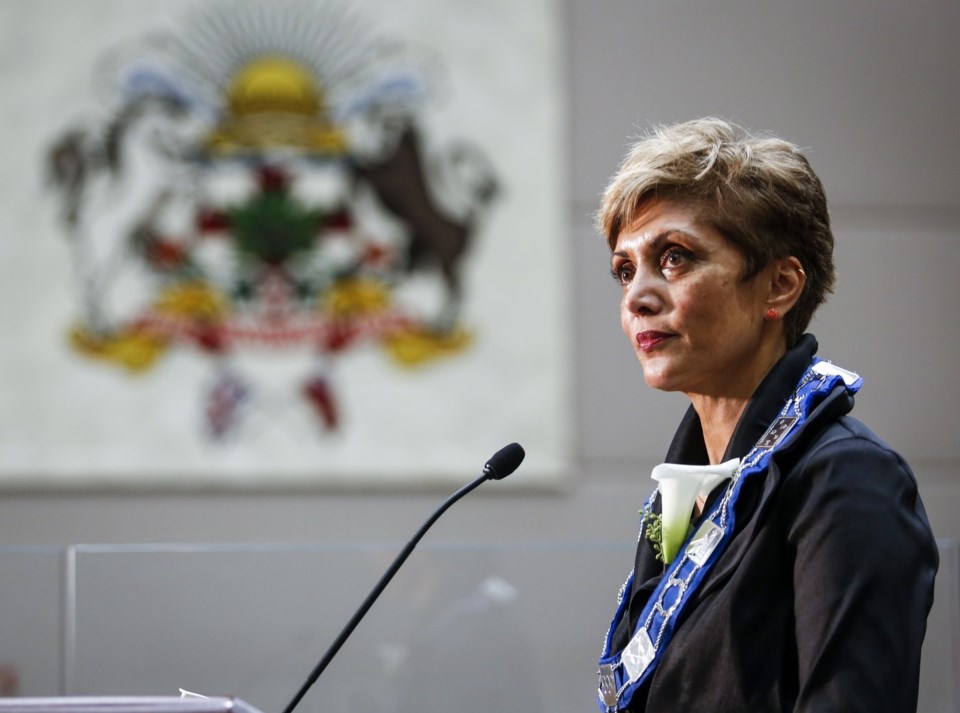CALGARY — A report on the Alberta government's proposed alignment for Calgary's Green Line light-rail transit project raises questions about the feasibility of an above-ground track, says Mayor Jyoti Gondek.
The government-commissioned report, partially released Wednesday after initially being kept confidential by Transportation Minister Devin Dreeshen over concerns about bidding integrity, says noise concerns, ease of construction and impact to existing properties need to be studied further if the city moves forward.
The report, produced by engineering firm AECOM, also notes that a "structural analysis" and a "detailed constructability review" were not completed as part of the undertaking.
"This omission raises serious questions about the feasibility of constructing an elevated Green Line through Calgary’s downtown core," reads a joint statement from Gondek and city councillors Andre Chabot and Peter Demong on Thursday.
"Additionally, the report indicates that the potential noise impact and the effects of an above-ground train through our downtown have only been superficially considered."
The province commissioned the report in September after it pulled its $1.53-billion funding commitment over cost and because the existing plan involved having trains tunnel through downtown.
When Dreeshen announced the new alignment Friday, he said it would have the same price tag as the city's existing plan, but city administration said Tuesday that the new alignment would carry with it an additional $1.3 billion in costs.
The report notes that the city would need to acquire access to an additional 3,900 square metres of right-of-way rights downtown if it were to move forward with the alignment endorsed by the province.
The city would also have to consider and make alternative plans for emergency responses in some cases as there would be minimal space between buildings and elevated train stations, the report says.
"We are not comfortable with the current level of uncertainty and risk associated with the proposed alignment and need to have real discussions with the province before bringing this proposal back to council," reads Gondek's statement.
Gondek, Chabot and Demong are calling on provincial officials to meet again to address these issues with the province's alignment.
"We urge all stakeholders involved to take these concerns seriously and to work collaboratively towards a solution that truly benefits the city of Calgary," the statement says.
In an email Thursday, Dreeshen didn't acknowledge the meeting request but said any risks and unexpected costs are the city's responsibility.
"They should seek to mitigate risks and look for savings wherever possible, rather than simply growing the estimate of the total project cost to account for a broader and broader range of potential risks," Dreeshen said.
"Alberta taxpayers are funding the construction of the Green Line, and through AECOM's work, we have prioritized ensuring maximum value for every dollar invested."
At an unrelated press conference Thursday, Premier Danielle Smith blamed the cost discrepancy between her government and the city on poor project planning.
"The problem that we've had with this project all along is improper scoping, improper costing," she said.
Since Smith has said council needs to make a decision in January, and with the federal government's $1.5 billion in funding expiring at the end of March without an approved alignment, two other city councillors say they've been put in an untenable position that's only being made worse through politics.
"You can't make knee-jerk decisions on something of this magnitude," said Coun. Sonya Sharp.
Sharp said she thinks finger pointing between the municipal and provincial governments has only led to confusion.
"This has been thrown back and forth so many times, but not in the appropriate communication channel," she said. "Because really what it's causing is a lot of uncertainty for Calgarians and now people that were super supportive of the Green Line ... are like 'just cancel it.'"
"We have to stop this," Sharp said.
Coun. Courtney Walcott said a point of frustration for him is that the provincial government has not included the municipality in its public communication about the new alignment.
"It's important to actually clarify that there's what they say publicly and then there's what council has actually received," Walcott said.
"I think the best description of that discrepancy is the fact that they were out on Friday talking about the AECOM report 12 hours before we even saw the first page."
For Sharp, a viable path forward on the project likely isn't achievable if the situation continues as it has.
"Everyone needs to take a step back, go back into the war room ... put your pencil down, listen to each other and figure out the best path forward for Calgarians."
This report by The Canadian Press was first published Dec. 19, 2024.
Jack Farrell, The Canadian Press

